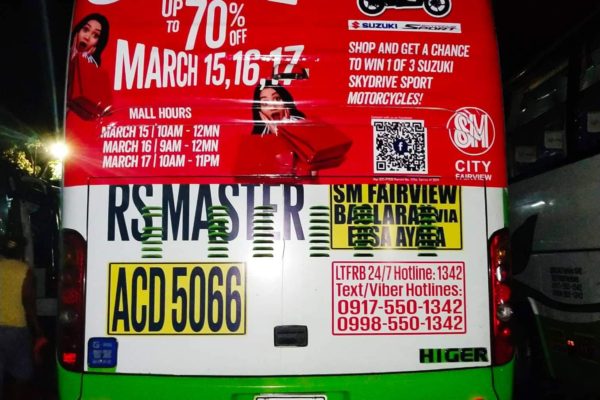Efficient Transit Advertising Philippines to Grow Your Audience
Efficient Transit Advertising Philippines to Grow Your Audience
Blog Article
Exactly How Transportation Advertising Can Change Public Transportation Spaces Into Dynamic Advertising Operatings Systems
Transit advertising and marketing holds significant capacity to redefine public transportation rooms into dynamic advertising platforms that involve and educate. By making use of innovative styles such as interactive stands and electronic displays, brands can not only get to a varied target market but also improve the total traveler experience. This approach creates a special possibility for brand names to get in touch with consumers in a setup that is often ignored. As we discover the complex benefits and developing methods of transportation advertising and marketing, it raises the concern of exactly how this improvement can redefine our communications with both brand names and the urban environment.
Benefits of Transportation Marketing

In addition, transit advertising is extremely economical compared to typical media. It enables marketers to achieve high impacts at lower expenses, making best use of return on investment. The captive target market of commuters supplies an opportunity for brands to share their messages to individuals that are typically receptive during their traveling times.
Additionally, the dynamic nature of transportation advertising enables projects to be upgraded frequently, making sure that messaging remains pertinent and prompt. This versatility can be critical in reacting to market patterns or advertising occasions, keeping the brand top-of-mind for consumers. Finally, the pervasive visibility of transit advertising and marketing adds to brand recall; duplicated exposure within familiar traveling contexts enhances brand name recognition and promotes consumer loyalty, eventually enhancing and driving sales brand track record.
Kinds of Transportation Advertising
Mass transit systems offer different styles for advertising and marketing, each dealing with various marketing approaches and target market engagement methods. One prominent type is exterior bus and train covers, which cover the whole lorry and develop a mobile billboard effect, enabling high exposure in metropolitan atmospheres. These wraps can capture attention as they traverse busy streets, reaching a diverse audience.
One more popular layout is indoor marketing, that includes posters, digital displays, and advertisements on transit seats. These positionings involve travelers throughout their trip, strengthening brand messaging in a constrained area. Digital presents, in certain, use the advantage of vibrant material, enabling marketers to upgrade messages in real-time.
Station advertising and marketing is likewise significant, featuring posters, banners, and interactive kiosks within transportation stations. These advertisements leverage foot website traffic and can target certain demographics based on place.
Lastly, advertising partnerships with transit authorities can lead to special campaigns, such as themed transportation experiences or events, improving the overall interaction with travelers. Each type of transportation marketing supplies distinctive benefits, enabling brand names to tailor their strategy to successfully reach their target audience within the public transport community.
Involving Commuters Effectively
Travelers are increasingly swamped with advertising and marketing messages during their day-to-day journeys, making it crucial for brands to engage them in cutting-edge ways. To capture interest in this jampacked space, advertisers must prioritize imagination and importance. Utilizing distinctive visuals and concise messaging can substantially boost the likelihood of engagement.
Interactive aspects, such as QR codes or increased fact features, can also transform static ads right into immersive experiences, fostering a deeper connection with the target market. Brand names need to concentrate on addressing commuters' needs and rate of interests, customizing messages to resonate with their lifestyle, whether through promotions for local companies or services developed to improve their commuting experience.
Furthermore, timing plays a vital function; tactically placing ads during optimal travelling hours can make best use of presence and influence. Involving travelers efficiently likewise involves leveraging social networks assimilation, enabling guests to share their experiences or promos directly from transit systems, consequently magnifying brand reach.
Essentially, effective involvement pivots on comprehending the commuter trip and producing engaging, interactive, and appropriate advertising experiences that not just record attention but also drive activity and loyalty. By doing so, brand names can change public transportation into a dynamic advertising and marketing platform that reverberates with its target market.

Measuring Advertising Impact
Exactly how can brand names precisely evaluate the effectiveness of their advertising and marketing campaigns en route atmospheres? Measuring the influence of transit advertising and marketing needs a complex technique that integrates qualitative and measurable metrics. One prevalent approach is tracking engagement via mobile analytics, where brands can examine foot traffic patterns and application interactions previously, throughout, and after campaigns.
Surveys can provide useful insights into brand name recall and consumer belief, permitting brands to assess how well their messages resonate with travelers. Additionally, checking social media interaction pertaining to particular projects can disclose shifts in public understanding and brand name conversation.

Moreover, teaming up with transportation firms can enhance measurement accuracy, as they typically have comprehensive group information on ridership fads. By incorporating these methodologies, brands can develop an extensive understanding of their marketing efficiency, making sure that their projects not just reach however also impact their target market properly.
Future Trends in Transportation Advertising And Marketing
A substantial change is prepared for en route marketing as technological developments and changing consumer actions improve the landscape. Transit Advertising Philippines. The combination of interactive media and electronic display screens is anticipated to boost involvement, enabling brands to deliver vibrant material that resonates with diverse audiences. As mass transit systems welcome wise technology, advertisers will certainly take advantage of real-time data analytics to customize messages based on passenger demographics and top article actions
Additionally, enhanced reality (AR) is positioned to reinvent the method travelers engage with ads. By providing immersive experiences, AR can change a mundane journey right into an engaging story that catches attention and cultivates brand commitment. This technology will likely motivate advertisers to produce more experiential projects that drive consumer communication.
Sustainability is another essential pattern influencing transportation advertising. As ecological awareness grows, brand names will significantly look for to line up with green practices, utilizing lasting products and advertising environment-friendly efforts within their projects.
Verdict
In look at more info verdict, transportation advertising offers significant advantages by enhancing brand visibility and involving a restricted target market. As fads advance, the possibility for cutting-edge communications in between commuters and brands is poised to expand, making certain that transportation advertising and marketing continues to be an essential part of modern-day advertising review and marketing methods.
Transportation marketing holds considerable potential to redefine public transportation rooms right into lively marketing platforms that engage and educate. The pervasive visibility of transportation marketing adds to brand recall; duplicated exposure within familiar traveling contexts strengthens brand recognition and promotes consumer commitment, eventually driving sales and improving brand name reputation.
Just how can brands accurately analyze the efficiency of their advertising projects in transit settings?In final thought, transit advertising and marketing provides significant benefits by improving brand name exposure and involving a restricted audience. Transit Advertising Philippines. As patterns develop, the possibility for ingenious communications between brand names and commuters is positioned to grow, making certain that transit advertising and marketing remains an essential element of modern-day advertising strategies
Report this page